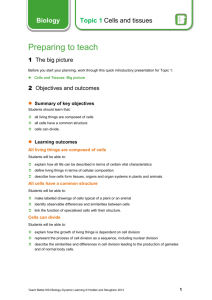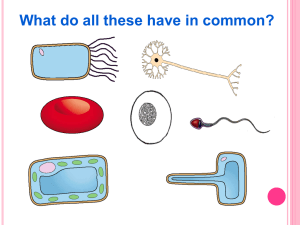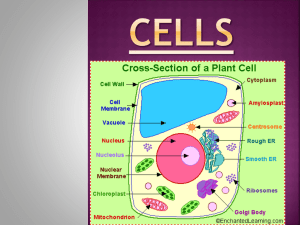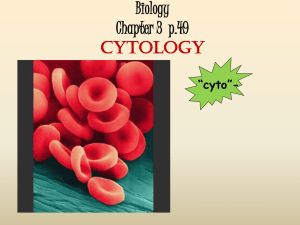Cells and tissues - Tackling differentiation
advertisement
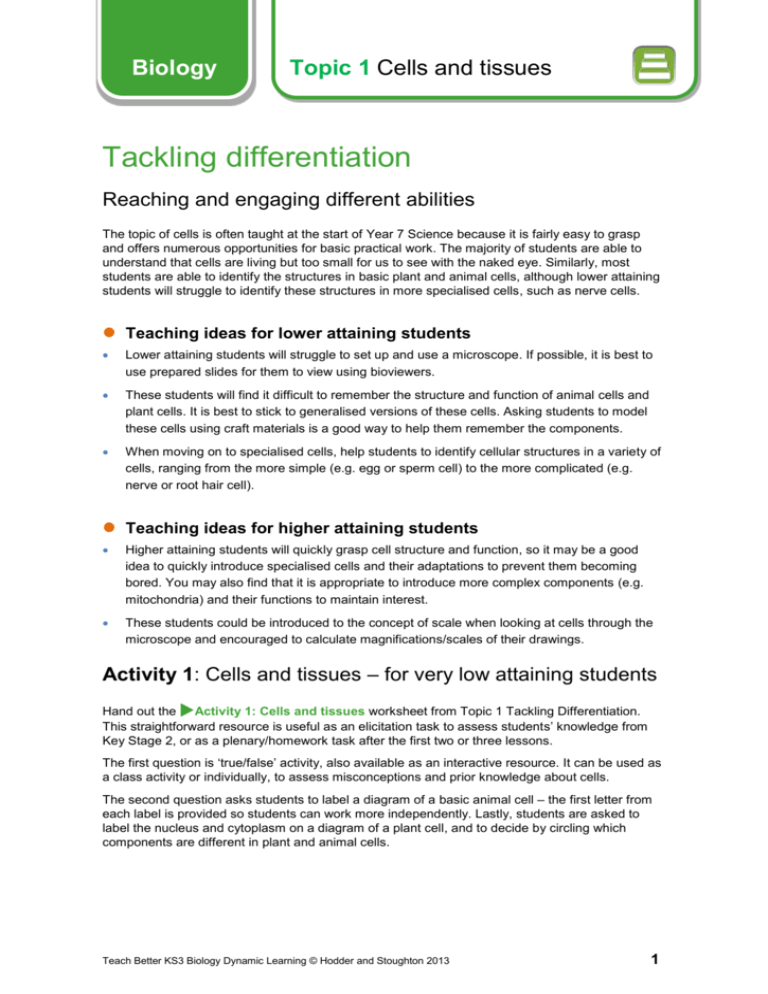
Biology Topic 1 Cells and tissues Tackling differentiation Reaching and engaging different abilities The topic of cells is often taught at the start of Year 7 Science because it is fairly easy to grasp and offers numerous opportunities for basic practical work. The majority of students are able to understand that cells are living but too small for us to see with the naked eye. Similarly, most students are able to identify the structures in basic plant and animal cells, although lower attaining students will struggle to identify these structures in more specialised cells, such as nerve cells. Teaching ideas for lower attaining students Lower attaining students will struggle to set up and use a microscope. If possible, it is best to use prepared slides for them to view using bioviewers. These students will find it difficult to remember the structure and function of animal cells and plant cells. It is best to stick to generalised versions of these cells. Asking students to model these cells using craft materials is a good way to help them remember the components. When moving on to specialised cells, help students to identify cellular structures in a variety of cells, ranging from the more simple (e.g. egg or sperm cell) to the more complicated (e.g. nerve or root hair cell). Teaching ideas for higher attaining students Higher attaining students will quickly grasp cell structure and function, so it may be a good idea to quickly introduce specialised cells and their adaptations to prevent them becoming bored. You may also find that it is appropriate to introduce more complex components (e.g. mitochondria) and their functions to maintain interest. These students could be introduced to the concept of scale when looking at cells through the microscope and encouraged to calculate magnifications/scales of their drawings. Activity 1: Cells and tissues – for very low attaining students Hand out the Activity 1: Cells and tissues worksheet from Topic 1 Tackling Differentiation. This straightforward resource is useful as an elicitation task to assess students’ knowledge from Key Stage 2, or as a plenary/homework task after the first two or three lessons. The first question is ‘true/false’ activity, also available as an interactive resource. It can be used as a class activity or individually, to assess misconceptions and prior knowledge about cells. The second question asks students to label a diagram of a basic animal cell – the first letter from each label is provided so students can work more independently. Lastly, students are asked to label the nucleus and cytoplasm on a diagram of a plant cell, and to decide by circling which components are different in plant and animal cells. Teach Better KS3 Biology Dynamic Learning © Hodder and Stoughton 2013 1 Biology • Topic 1 • Cells and tissues Answers and guidance Answers 1 A: True B: False Teacher guidance and class discussion points This question helps to identify misconceptions such as ‘cells are not living’ and ‘you can see them without a microscope’. C: True D: True 2 d) Animal cell Students who struggle with this could be shown a diagram to help them. See the The big picture presentation in Topic 1 Preparing to Teach. 3 c) Plant cell d) Chloroplast, vacuole and cell wall circled Students may confuse cell membrane with cell wall – remind them that although a plant cell and animal cell both have a membrane, it is only the plant cell that has a cell wall. Activity 2: Cells and tissues – progressive for mixed groups Hand out the Activity 2: Cells and tissues worksheet from Topic 1 Tackling Differentiation. This is designed to become progressively more challenging and enables the level of understanding of the student to be gauged. Before asking students to answer question 1, it is necessary to have first covered a lesson on microscopes and looking at cells under a microscope. In question 1 students are first asked to label the nucleus, cytoplasm and cell membrane on a diagram of a ‘cheek’ (animal) cell. They are then asked to make suggestions as to how the student could see the cells more clearly – by adding a stain. They are then given a simple calculation to do, to work out the magnification of the image based upon the magnification of the eyepiece and objective lenses. Most students should have no difficulty with this question. Again, most should be able to answer question 2, which covers cell structure and the function of the chloroplast, nucleus and vacuole. Some students may struggle with the term ‘function’, however, and students often state that the nucleus is the ‘brain’ of the cell. In the third, more difficult, question, students are asked to apply their knowledge to suggest, and give reasons for, adaptations a plant may have to survive in three challenging environments. Teach Better KS3 Biology Dynamic Learning © Hodder and Stoughton 2013 2 Biology • Topic 1 • Cells and tissues Answers and guidance Answers Teacher guidance and class discussion points 1 a) Cell nucleus, cytoplasm and cell membrane correctly labelled. b) Use a coloured stain to see the cells more clearly. c) 4 × 10 = 40 2 a) A chloroplast – where photosynthesis occurs. b) The nucleus – controls the cell. In part b) students may name a specific stain, e.g. iodine. Students may need reminding of the term ‘function’ – i.e. its job or role. c) The vacuole – contains sap to maintain the cell’s Part c) could link to explain why plants wilt/die if shape. you overwater them. 3 a) A cactus in a desert – suitable suggestions may Students unfamiliar with these habitats could be include long roots to absorb water; swollen stems to shown images or video clips (for example at hold as much water as possible; small leaves/spines to www.bbc.co.uk/nature/habitats) reduce water loss and for protection against animals. In part a), higher attaining students may b) A gorse bush clinging to a very windy rock face – suggest a large vacuole to maintain cell shape suitable suggestions may include long, strong roots to during periods of water loss. anchor the plant, low-lying plant shape to reduce the effects of the wind. c) A fern on a very shady woodland floor – suitable suggestions may include large leaves or lots of chloroplasts, to maximise photosynthesis in a location that doesn’t receive much sunlight. Activity 3: Cells and tissues – for higher attaining students and extension work Hand out the Activity 3: Cells and tissues worksheet from Topic 1 Tackling Differentiation. This builds upon sub-topics: cell structure; specialised cells and tissues. It is a useful resource for a plenary at the end of the topic; question 3 involves research and could be set as a homework task. The first question is based upon a student carrying out a practical by looking at plant cells down a microscope. The question asks students to first identify a root hair cell from an image, then draw and label it and state the function of its components. The second and third questions are more challenging and require the student to apply their knowledge of cells and tissues to an unfamiliar situation. Question 2 is about adaptation of specialised cells in the context of infertility. In question 3, students are first given information about early skin grafts and then asked to carry out research into the use of skin cells to grow skin tissue in the laboratory. This provides students with an opportunity to use their knowledge of the structure of tissues. Teach Better KS3 Biology Dynamic Learning © Hodder and Stoughton 2013 3 Biology • Topic 1 • Cells and tissues Answers and guidance Answers Teacher guidance and class discussion points 1 a) i) They do not contain chloroplasts, unlike other plant Students may identify the cell as a root cells. hair cell. ii) They have come from the plant’s roots. b) Nucleus, vacuole, cell wall and cytoplasm correctly labelled. c) Nucleus – controls the cell; vacuole – contains sap to maintain cell shape; cell wall – for protection and to hold cell shape; cytoplasm – site of cell’s chemical reactions. 2 a) Sperm cells have a strong powerful tail to swim – without Some students may also state that the this they are unable to swim up the oviduct to find and fertilise sperm have a ‘collar’ that contains a high an egg cell; sperm cells are small and produced in a high number of energy-producing number – if fewer were produced there would be a decreased mitochondria. chance of the egg being found and fertilised. b) Egg cells have a huge energy store – if they did not have this a dividing fertilised egg cell would not be able to grow; egg cells have a selective membrane – if there are problems with this a sperm may be unable to get through and fertilise the egg. 3 Students need to produce a short report on the use of a The short video at patient’s cells for producing skin tissue which can be grafted http://science.kqed.org/quest/video/growi to a patient. They may state advantages such as: less chance ng-skin/ is useful in explaining the of rejection; more sterile; will look more natural; no need to process, and there is also suitable take skin and scar another area on the body. They may state information at disadvantages such as: takes a long time for the cells to http://science.howstuffworks.com/innovati divide and grow to form enough tissue; expensive. on/everyday-innovations/lab-grownskin.htm Teach Better KS3 Biology Dynamic Learning © Hodder and Stoughton 2013 4
